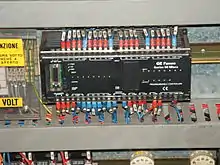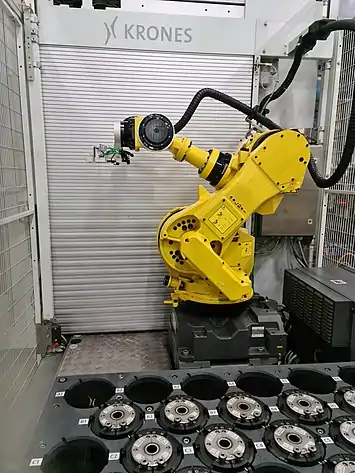FANUC
FANUC (/ˈfænək/ or /ˈfænʊk/; often styled Fanuc) is a Japanese group of companies that provide automation products and services such as robotics and computer numerical control wireless systems.[6] These companies are principally FANUC Corporation (ファナック株式会社, Fanakku Kabushikigaisha) of Japan, Fanuc America Corporation of Rochester Hills, Michigan, USA, and FANUC Europe Corporation S.A. of Luxembourg.
| Type | Public KK |
|---|---|
| TYO: 6954 TOPIX Core 30 Component TOPIX 100 Component Nikkei 225 Component | |
| Industry | |
| Founded | 1958[1] (as a subsidiary of Fujitsu) 1972 (as an independent company) |
| Founder | Seiuemon Inaba, Dr. Eng.[1] |
| Headquarters | Oshino-mura, Minamitsuru-gun, Yamanashi Prefecture, Japan 35°26′43.8″N 138°50′34.1″E |
Area served | Worldwide |
Key people | Dr. Eng. Seiuemon Inaba (Honorary Chairman) Dr. Eng. Yoshiharu Inaba (President & CEO) |
| Products | |
| Revenue | |
| Total assets | |
| Total equity | |
Number of employees | 7,866 [3] |
| Website | Official website |
| Footnotes / references [1][4][5] | |


FANUC is the largest maker of industrial robots in the world. FANUC had its beginnings as part of Fujitsu developing early numerical control (NC) and servo systems. FANUC is acronym for Fuji Automatic NUmerical Control.[7]
History
In 1955, Fujitsu Ltd. approached Seiuemon Inaba(ja:稲葉清右衛門), who was then a young engineer, to lead a new subsidiary purposed to make the field of numerical control. This nascent form of automation involved sending instructions encoded into punched or magnetic tape to motors that controlled the movement of tools, effectively creating programmable versions of the lathes, presses, and milling machines. Within three years after spending heavily in R&D, he and his team of 500 employees shipped Fujitsu’s first numerical-control machine to Makino Milling Machine Co.[8] In 1972, the Computing Control Division became independent and FANUC Ltd was established.[9] The next phase of expansion would be computer numerical control, which relied on G-code,a standard programming language. At the time, the 10 largest CNC companies in the world were based in the U.S., however by 1982, FANUC had captured half of the world CNC market.[10]
FANUC is listed on the first section of Tokyo Stock Exchange and is a constituent of the TOPIX 100[11] and Nikkei 225[12] stock market indices. It is headquartered in Yamanashi Prefecture.
In 1982, FANUC entered into a joint venture with General Motors Corporation (GM), called GMFanuc Robotics Corporation, to produce and market robots in the United States. The new company was 50 percent owned by each partner and was based in Detroit, with GM providing most of the management and Fanuc the products. In 1987, Fanuc entered into a joint venture with General Electric Company (GE). The two companies formed GE Fanuc Automation to manufacture computerized numerical control (CNC) devices. GE stopped making its own CNC equipment and turned its Charlottesville, Virginia, plant over to the new company which produces Fanuc CNC devices. Fanuc adopted the German engineering slogan Weniger Teile, which means "fewer parts;" machines with fewer parts are cheaper to produce and easier for automatons to assemble, resulting in higher reliability and lower manufacturing costs.
The company's clients include numerous U.S. and Japanese automobile and electronics manufacturers. Use of industrial robots has allowed companies like Panasonic in Amagasaki to run factories which produce 2 million television sets a month (mostly high end plasma LCD screens) with just 25 people.[13]
FANUC has over 240 joint ventures subsidiaries, and offices in over 46 countries.[14] It is the largest maker of CNC controls by market share with 65% of the global market.[15] and is the leading global manufacturer of factory automation systems.[16]
Subsidiaries and joint ventures
FANUC Europe Corporation S.A., a sister company, is headquartered in Luxembourg, with customers in Europe, and which provides sales, service and support in Europe and abroad.
FANUC America Corporation is responsible for FANUC operations in North and South America. The current incarnation, organized in 2013, unifies FANUC activities in the Americas, including the former FANUC Robotics America Corporation (1992-2013) and FANUC CNC America (2010-2013), which succeeded an earlier incarnation of FANUC America Corporation.
FANUC Robotics America Corporation (1992-2013) supplied robotic automation in North and South America, with over 240,000 robots installed. It also produced software, controls, and vision products that aid in the development of robotic systems. Headquartered in Rochester Hills, Michigan, the company had 10 regional locations in the U.S., Canada, Mexico and Brazil. The company provided these systems for applications including automotive and fabricated metals to medical devices and plastics. It was founded in 1982 as a joint venture between FANUC Ltd and General Motors Corporation, named GMFanuc Robotics Corporation. A staff of 70 began work at the GM Technical Center in Warren, Michigan. In 1992, the company became a wholly owned subsidiary of FANUC Ltd of Oshino-mura, Japan. The company was a member of the Robotics Industries Association (RIA) and of the International Federation of Robotics (IFR).

In 2010, FANUC America Corporation and the prior CNC business unit from GE Fanuc Intelligent Platforms in the US were combined into a new company by the name of FANUC CNC America. This business unit was a wholly owned subsidiary of FANUC Ltd. of Japan and offered CNC systems, lasers, Manufacturing Intelligence software products, field repairs and advanced technical services, expanded training classes, a vast inventory of CNC replacement parts, PCB motor repair and return, field support, and CS-24 after hours support. It was headquartered in the Chicago suburb of Hoffman Estates, Illinois. It offered CNC and laser technical services, training, replacement parts, PCB and motor repair and return, field support, and after hours support. It had over 30 locations in the U.S., Canada, Mexico, Brazil and Argentina. The company provides these services to machine tool builders, machine tool dealers, and small mom and pop tool shops across a variety of industries. In 1977, the company was established as a wholly owned subsidiary of FANUC Ltd of Oshino-mura, Japan.
GE Fanuc Intelligent Platforms (1986-2010) was a joint venture between General Electric and FANUC Ltd. In 2009, GE and FANUC Ltd. agreed to split, with FANUC Ltd. retaining the CNC business. GE renamed its part of the business GE Intelligent Platforms.[17][18][19]
Fanuc India operations are led by Sonali Kulkarni.
FANUC NC controller
Control / device naming conventions
Each generation of the FANUC numerical control system has different levels of device control capabilities, and these are generally referred to by a model or series number.
Each controller model is typically available with several device control capabilities, depending on what software functions are licensed for use on that device. Some common control capabilities are:
- M - Milling
- T - Turning (lathe)
- TT - Twin Turret
- P - Punch press
- G - Grinding
Within each model name, there can also be generational updates for each model, usually indicated by a trailing letter.
Model 0 is somewhat unusual in that both the number zero and the letter O are used interchangeably to indicate the model.
There is no specific syntax for distinguishing the model from the device type and series, with spaces or dashes or slashes, which can result in difficulty searching for information, parts, and service for this equipment. For example, in the FANUC-0 series, these are all valid identifications for various types of NC controls and machines:[20]
| Various model names | Type | Series | Notes |
|---|---|---|---|
| FANUC-0MA, FANUC 0-MA, FANUC 0M-A, FANUC 0M/A, FANUC 0-M-A, FANUC 0-M/A, FANUC 0 M-A, FANUC 0 M/A, FANUC-0M Model A, FANUC 0-M Model A, FANUC 0/M Model A | Milling | A | number 0 |
| FANUC-OPA, FANUC O-PA, FANUC OP-A, FANUC OP/A, FANUC O-P-A, FANUC O-P/A, FANUC O P-A, FANUC O P/A, FANUC-OP Model A, FANUC O-P Model A, FANUC O/P Model A | Punching | A | letter O |
| FANUC-0TB, FANUC 0-TB, FANUC 0T-B, FANUC 0T/B, FANUC 0-T-B, FANUC 0-T/B, FANUC 0 T-B, FANUC 0 T/B, FANUC-0T Model B, FANUC 0-T Model B, FANUC 0/T Model B | Turning | B | number 0 |
| FANUC-0TTB, FANUC 0-TTB, FANUC 0TT-B, FANUC 0TT/B, FANUC 0-TT-B, FANUC 0-TT/B, FANUC 0 TT-B, FANUC 0 TT/B, FANUC-0TT Model B, FANUC 0-TT Model B, FANUC 0/TT Model B | Twin Turret | B | number 0 |
| FANUC-0GC, FANUC 0-GC, FANUC 0G-C, FANUC 0G/C, FANUC 0-G-C, FANUC 0-G/C, FANUC 0 G-C, FANUC 0 G/C, FANUC-0G Model C, FANUC 0-G Model C, FANUC 0/G Model C | Grinding | C | number 0 |
NC controller capabilities
When separate computer aided manufacturing software is used to control these different systems, the model differences can be used to tell the manufacturing software how to more efficiently use the system programming capabilities. Some FANUC NC controllers include:
| Control name | Series or version | Differences and capabilities |
|---|---|---|
| FANUC 20 | Series A | Series 20A was a two axis (usually lathe) NC controller that used stepper motors. Resolution was 10μm. Optional tool offsets were via "decade" switches and selected by program. A machine reference point was optional. |
| FANUC 20 | Series B | Series 20C had a 1μm resolution |
| FANUC 30 | Series A | Series 30A was a three axis (milling) NC controller that used stepper motors. Resolution was 10μm. |
| FANUC 30 | Series B | Series 30C had a 1μm resolution |
| FANUC 2000 | Series A | Series 2000C was a 2 axis (usually lathe) CNC controller that used DC thyristor drives and had a 1 μm resolution. User memory was optional. Data was displayed by a one-word LCD, addresses (letters such as G, F, X, Y, &etc) were selected by buttons on the control panel. A two-line position display was optional. |
| FANUC 3000 | Series A | Series 3000C was a 3 axis (usually milling) CNC controller that used DC thyristor drives and had a 1 μm resolution. User memory was optional. Data was displayed by a one-word LCD, addresses (letters such as G, F, X, Y, &etc) were selected by buttons on the control panel. A three-line position display was optional. |
| There is no model 4/4000, likely because it is a Japanese unlucky number. But in recent days these models are also available because of the application requirement. | ||
| FANUC 5 | Series A | System 5 was similar to 2000/3000, it was an 8 bit CNC that used a standard paper tape drive and optional user memory with battery back up. 5T had options of constant surface speed, Multiple repetitive cycles G71, G72, G73, G74, G75, and G76. Tool nose radius compensation was available. Incremental and absolute programming were possible in the same block. The display was a one-word LCD the same as the 2000/3000. |
| FANUC 7 | Series A | Fanuc System 7 was a joint venture between Fanuc and Siemens because Fanuc were then unable to produce a 5 axis controller. |
| FANUC 6 | Series A | System 6A was the first Fanuc controller based on the Intel 8086 16 bit micro processor. System 6A had the standard one-word LCD, but was optionally available with a 9" CRT. It was available with Custom Macro (variable programming with user defined calculations) and could hold multiple programs in its memory. Non-volatile Bubble memory was used. |
| FANUC 5 | Series B | |
| FANUC 6 | Series B | System 6B had a standard CRT, up to 512 kb of memory and most of the programming features found in modern CNC machines. Whereas the earlier systems were obsolete within a few years of manufacture, system 6 machines are still in operation today (2018), 35 years later. Early system 6 machines used the "Black Cap" thyristor drives from earlier controls, later machines from 1981 onwards used the legendary "Yellow Cap" transistor drives. AC spindle drive were optional with system 6 and these were reliable, unlike the earlier DC units. 8 bit paper readers or RS232C ports were used to input programs. 8 kb of bubble memory was standard, 128 kb was a $10,000 + option. System 6 level two came out in 1983 and is distinguished by 3 extra buttons on the control panel. Level 2 had many bug fixes and a few extra features, notably, 5 axis milling. later 6MB systems had an optional 14" CRT with expanded operator panel and optional FAPT programming. System 6 had a built in PLC. |
| FANUC 3 | Systems 3 and 2 were low-cost alternatives to system 6, although a fully optioned system was quite powerful, if somewhat slow in processing. System 3 used battery-backed CMOS memory with 4 kb being standard. System 3TF had a 12" 4 colour CRT and FAPT automatic programming. 3M and 2T controllers were typically used on simple machines like CNC drills and gang-tooled lathes. | |
| FANUC 10 | ||
| FANUC 11 | ||
| FANUC 15 | ||
| FANUC 0 | Series A, 1985–1986 | |
| FANUC 0 | Series B, 1987–1989 | |
| FANUC 0 | Series C, 1990–1998 | |
| FANUC 6 | ||
| FANUC 12 | ||
| FANUC 16i | ||
| FANUC 18i | ||
| FANUC 21i | ||
| FANUC 30i[21] | First production: 2003 | |
| FANUC 31i[21] | First production: 2004 | |
| FANUC 32i[21] | First production: 2004 | |
| FANUC 160[22] | ||
| FANUC 180[22] | ||
See also
References
- "Company Outline". FANUC Corporation. Retrieved March 31, 2013.
- http://www.fanuc.co.jp/en/ir/annualreport/pdf/annualreport2017_e.pdf
- "Fanuc Corp. ADR Profile". MarketWatch.com. Retrieved 2020-01-09.
- "FANUC Corporate Profile". Google Finance. Retrieved March 19, 2014.
- "Annual Report 2013" (PDF). FANUC Corporation. February 6, 2014. Archived from the original (PDF) on March 20, 2014. Retrieved March 31, 2013.
- La comunicazione è wireless [Communication is wireless]. La Chimica e l'Industria (in Italian). January–February 2008. p. 60.
- "FANUC News 2015, (pdf-page-2 then scroll-right to see pdf-page-3-bottom-part)" (PDF). fanuc.co.jp. Archived from the original (PDF) on 2016-03-24. Retrieved 2016-06-24.
- "This Company's Robots Are Making Everything—and Reshaping the World". Bloomberg. Bloomberg. Retrieved 29 October 2017.
- "FANUC's Management - Profile". FANUC Corporation. Retrieved 2008-06-06.
- "The History of Fanuc". EdTech. MCC. Retrieved 29 October 2017.
- "TOPIX Core30 Components" (PDF). Japan Exchange Group. Archived from the original (PDF) on May 13, 2014. Retrieved March 19, 2014.
- "Components:Nikkei Stock Average". Nikkei Inc. Retrieved March 19, 2014.
- TrustedReviews.com Panasonic Press Tour Japan 2007 p2-3
- "Annual Report 2015" (PDF). FANUC Corporation. Retrieved January 23, 2016.
- "FANUC company profile". ENGINEERING.com, Inc. Retrieved September 17, 2014.
- "FANUC History". FANUC Europe Corporation. Retrieved March 19, 2014.
- American Machinist, GE, Fanuc Agree to Split Archived 2011-07-07 at the Wayback Machine
- "How Capital Investment Tax Credits Could Help Rebuild America's Manufacturing Sector". Commonweal Institute. Archived from the original on 2011-04-23. Retrieved 2010-10-21.
- "GE Fanuc Joint Venture Dissolved". NBC29. Retrieved 2010-10-21.
- Memex Automation - Fanuc 0 M/T Model C Serial (RS232) Connection Guide "Archived copy" (PDF). Archived from the original (PDF) on 2012-03-14. Retrieved 2011-04-12.CS1 maint: archived copy as title (link)
- "CNC Series 30i/31i/32i" (PDF). Archived from the original on February 2, 2013. Retrieved 2014-01-29.CS1 maint: bot: original URL status unknown (link)
- Fanuc Control History NC to Fanuc CNC Systems
| Wikimedia Commons has media related to FANUC. |
External links
- FANUC Corporation (in English)
- FANUC America Corporation
- FANUC Robotics Corporation
- FANUC Europe Corporation
- FANUC UK Ltd
- Hoover's Profile: FANUC CORPORATION
- FANUC's thumbnail overview of the history of FANUC CNC
- FANUC Introduces R-30iB Plus Robot Controller
- Finding FANUC powered CNC machine tools in the USA
